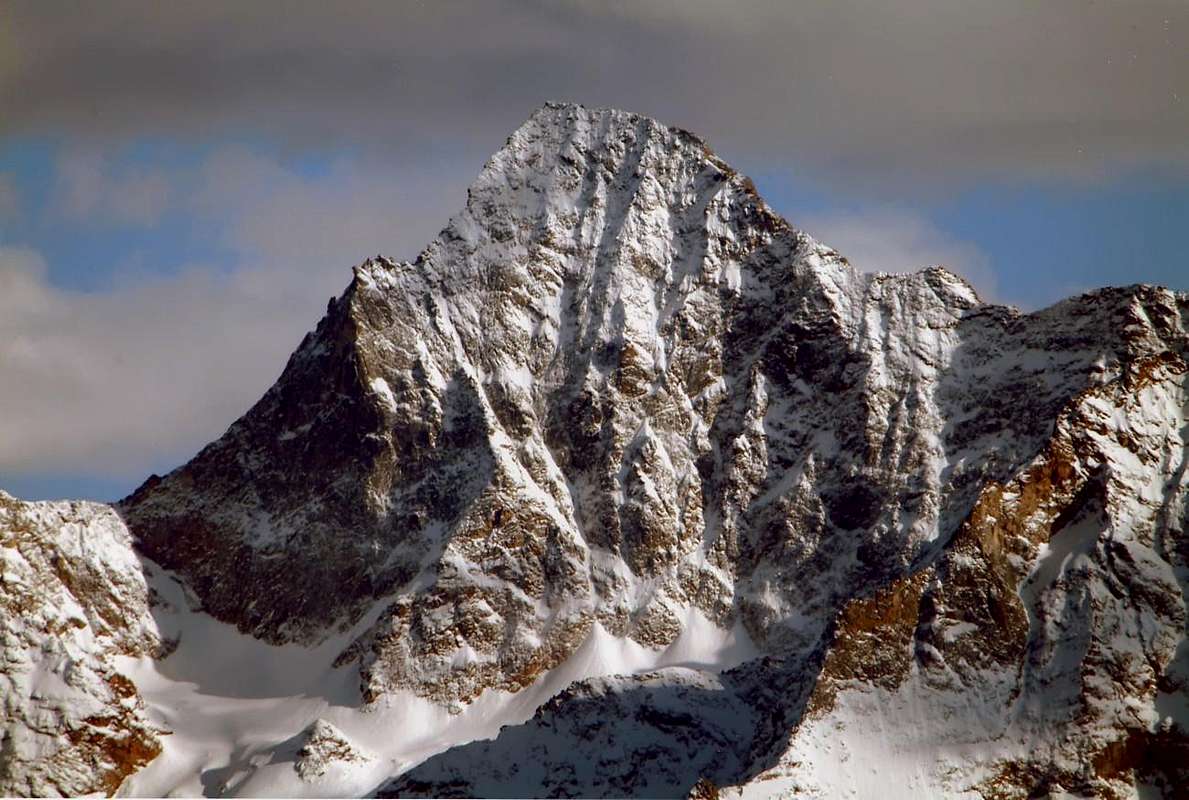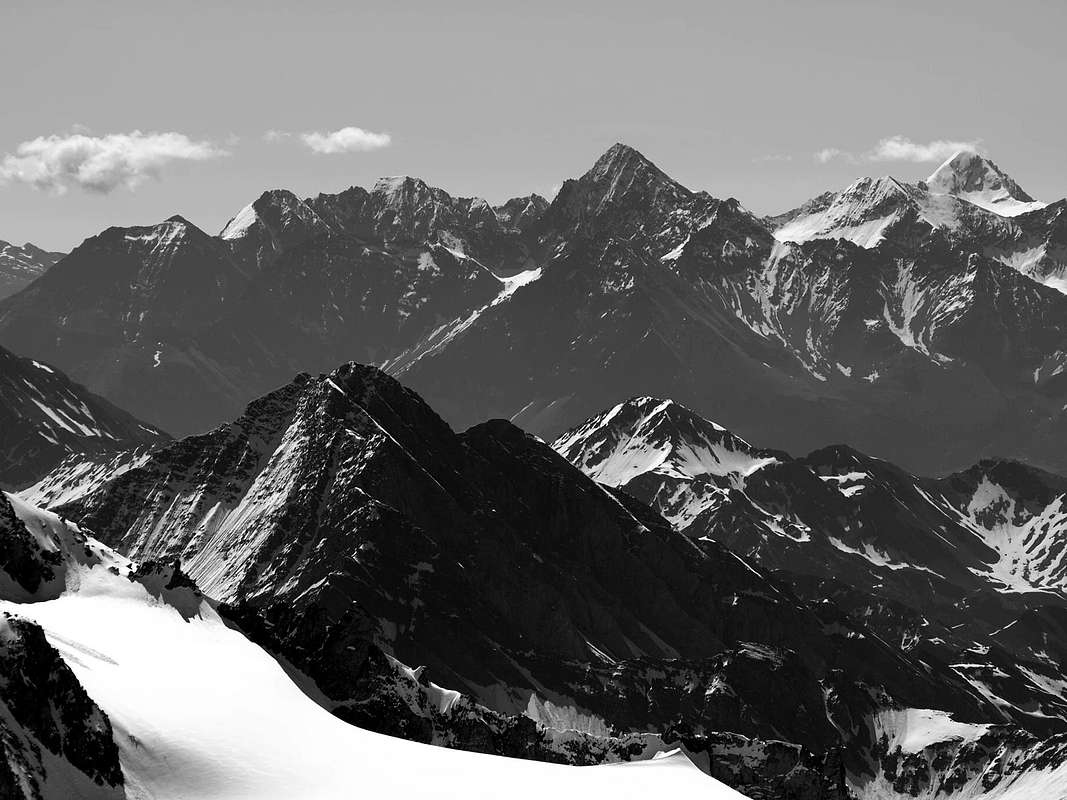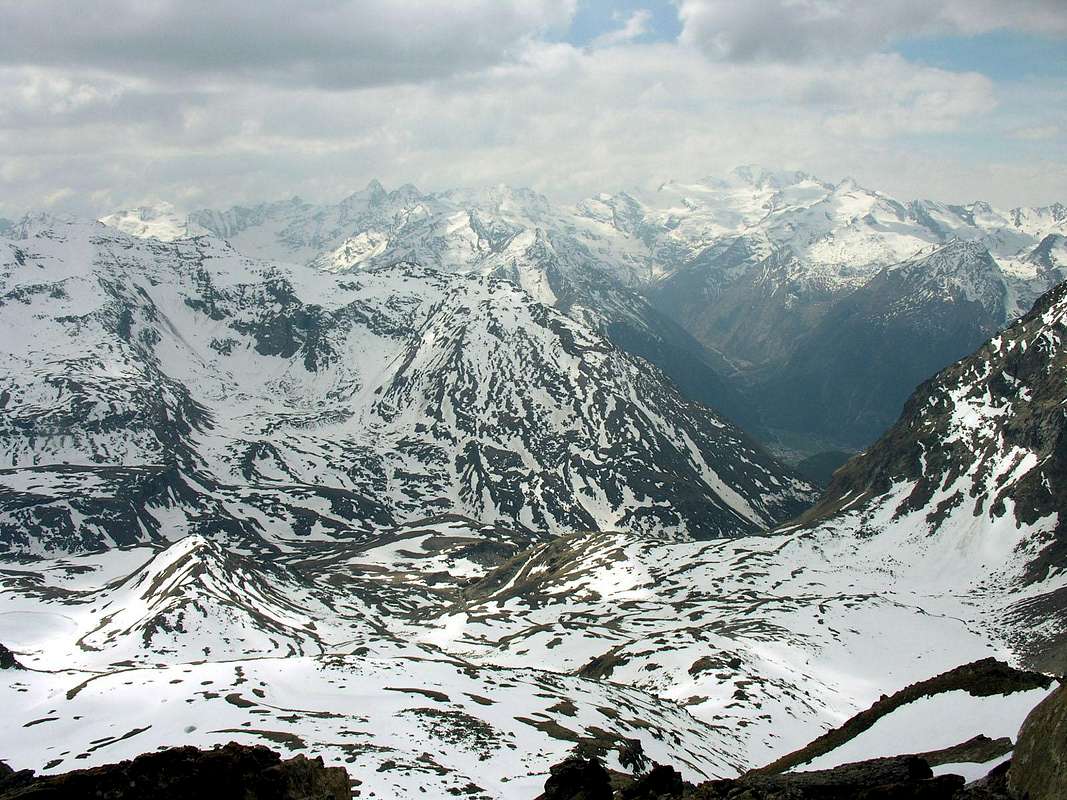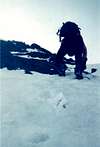-
 9313 Hits
9313 Hits
-
 76.66% Score
76.66% Score
-
 7 Votes
7 Votes
|
|
Fact Sheet |
|---|---|
|
|
Aosta |
ABOVE the OVERVIEW

Accounts, Informations and Advices for Hiking & Mountaineering-Climbing
We indicate by means of a small schematic preamble, the ones that are the most famous or known Emilius or ridges and walls of the surrounding mountains, we will consider the most challenging climbs and the most popular. We will analyze only the area around this mountain part, in a narrower sense, the same, or on the Central Valley of Dora Baltea Stream, near the City of Aosta in the stretch between the Towns of Aymavilles to the West and to the East of Saint Marcel with the above Pila Basin and in succession, always from West to East, the Vallons of Dard/Comboé/Arbole, of the Arpisson, Laures and Saint Marcel. In the Southwestern boundary of the zone is bounded by the Grand Torrent Eyvia that descends from the Valley of Cogne, in which the interesting part to us is facing north with another valley, this Arpisson said, and the much larger and extended in the Vallon of the Grauson, this will only discuss the ramification of the left (West) or Lussert, and will exclude all but the opposite or Doreire that dates back to Punta Tersiva (3515m). In fact, the extreme limit we have taken into account is the Hill of Saint Marcel or Col Corona('s), located in the extreme South of the valley, which is, strictly speaking, the Eastern border of this group of mountains.
For convenience, we will divide the Group of Emilius by Subgroups
of the three Roèses (3357m) to the East, from the Tower of Salé and Becca as Col Saint Marcel.
the Subgroup of the Point Garin (3461m) to the South, from the Hill of Arolle to the Arpisson Point.
and Point of the Valletta (3090m) to the West-southwest, from the Col Garin to Punta de la Pierre.
Section by section, we will give you concise information on the history and composition of these faces and ridges, starting from the Maximum Peak and other mountains to the major highlight; also some details and notes, as well as techniques on the various ways forward. From the most famous and well known to those less important, but perhaps more interesting and fun, or simply view.
The overall difficulty are listed with the traditional Scale U.I.A.A. and with the progressive acronyms F, PD, AD, D, MD and ED, ranging from easy to extremely difficult, as regards the steps are evaluated by the I° to VI°. In both cases may be accompanied by signs - or +, depending on whether you wish to signal a decrease or an increase of the same difficulties. The slopes or ice couloirs or goulottes, just for the truth, are stated in degrees of slope (= °). To note, in each case, which are the preferred paths in ridge rather than not on the walls, even on those, in monolithic appearance, as the Black Triangle of Emilius; actually the quality of the rock, everywhere, leaves much to desired, being almost always broken and presenting objective dangers for the existing suspended material. The climbing is safe only in short stretches, where it is more compact, but that can be counted on the fingers, even the paths on the ridge require caution at all times to the same considerations. We are far from protogine of Mont Blanc or the Gran Paradiso granite! These considerations also apply to other groups of neighboring Tersiva's Point, Mount Glacier, Mount Avic, there farthest from Champorcher Valley on the border with Piedmont, Rosa of the Banchi.
There have been attempts to enrich this exhibition with anecdotes, stories personalized or personal memories of friends or acquaintances, guides or other climbers or just for the one that says little and sparse literature, incidentally as for all minority groups.
Hoping to please ...
^ ^ "Edges", by Osw
Possiamo indicare, tramite un piccolo preambolo schematico, quelle che sono le più famose o conosciute creste e pareti dell'Emilius (3559m) o delle montagne circostanti; prenderemo in considerazione le ascensioni più impegnative e le maggiormente frequentate. Analizzeremo solo quell'area intorno a questa montagna facente parte, in senso più ristretto, della medesima; ovvero concernente la Valle Centrale della Dora Baltea, presso la Città di Aosta nel tratto compreso tra i Comuni di Aymavilles ad Occidente e di Saint Marcel ad Oriente con la soprastante Conca di Pila ed in successione, sempre da Ovest ad Est, i Valloni del Dard/Comboé/Arbole, dell'Arpisson, delle Laures e di Saint Marcel. A Sudovest il confine della zona é delimitato dal Torrent Grand Eyvia discendente dalla Valle di Cogne, nella quale la parte a noi interessante é rivolta a Settentrione con un altro vallone, anche questo detto di Arpisson, ed il ben più vasto ed esteso Vallone del Grauson; di questo tratteremo solo nella ramificazione di sinistra (Ovest) o di Lussert, mentre escluderemo quasi del tutto l'opposta o di Doreire risalente insino alla Punta Tersiva (3515 m). Infatti il limite estremo da noi preso in considerazione risulta esser il Colle di Saint Marcel o di Corona(s), sito nella parte estrema e Meridionale dell'omonima valle, che costituisce, in senso stretto, il confine Est di questo gruppo di montagne.
Per comodità, divideremo il Gruppo dell'Emilius dai Sottogruppi
delle tre Roèses (3357 m) ad Est, dalla Torre di Salè e Becca al Colle di Saint Marcel.
della Punta Garin (3461 m) a Sud, dal Colle di Arolle alla Punta di Arpisson.
e della Punta della Valletta (3090 m) ad Ovest-sudovest, dal Col Garin alla Punta de la Pierre.
Sezione per sezione, vi doneremo concise informazioni sulla storia e sulla composizione di queste pareti e creste, partendo dalla Vetta Massima e fino alle altre montagne notevoli di evidenziazione; inoltre alcuni ragguagli e note informative, nonché tecniche, sulle varie vie da percorrersi. Da quelle più rinomate e conosciute a quelle meno importanti ma, forse, più interessanti e divertenti o, semplicemente, panoramiche.
Le difficoltà complessivente sono elencate con la tradizionale Scala U.I.A.A. e e con la progressiva siglatura di F, PD, AD, D, MD ed ED, che vanno dal Facile all'Estremamente Difficile; per quanto concerne i passaggi vengono valutati dal I° al VI°. In entrambi i casi possono essere assecondati dai segni - oppure +, a seconda dal fatto che si voglia segnalare una diminuzione od un aumento delle difficoltà medesime. I pendii glaciali o le goulottes o couloirs, pochi per la verità, vengono valutati in gradi di pendenza (= °). Da annotarsi, in ogni caso, che sono da privilegiare i percorsi in cresta piuttosto che non sulle pareti, anche su quelle, in apparenza monolitiche, come il Triangolo Nero dell'Emilius; in realtà la qualità della roccia, ovunque, lascia alquanto a desiderare, essendo quasi sempre rotta e presentando pericoli oggettivi per il materiale sospeso esistente. L'arrampicata rimane sicura soltanto in brevi tratti, ove é più compatta, ma che si contano sulle dita delle mani; anche i percorsi in cresta richiedono sempre prudenza per le medesime considerazioni. Siamo ben lontani dal protogino del Monte Bianco o dal granito del Gran Paradiso! Queste considerazioni valgono anche per gli altri gruppi viciniori della Tersiva, del Mont Glacier, del Monte Avic e, laggiù più lontana in Valle di Champorcher ai confini con il Piemonte, della Rosa dei Banchi.
Si é cercato di arricchire questa esposizione con aneddoti, racconti personalizzati o ricordi personali, di amici o conoscenti, guide oppure altri alpinisti o, semplicemente, per quello che riporta una scarsa e scarna letteratura, daltronde come per tutti i gruppi minori.
Sperando di far cosa gradita ...
The Group of Mount Emilius from Salé Tower (left) to Vallaisan Pass and, in distance, Tersiva Point, by Antonio
^ ^ ^ From a "natural & uncontaminated" EMILIUS to Great Paradise Mountain Chain or Southwestern View, by marco87.
West-northwest Ridge or The "CHAINED" Emilius
The history of this beautiful and long ridge that links the Monte Emilius to her younger sister Becca of Nona, almost an arm on the shoulder of the other, has a twofold face with diametrically opposed aspects. On one side of a ridge of classic and not so difficult nor easy path and see that since 1902, the year of its first ascent in 2004, the year of the opening of the Via Ferrata on the same, just pass a dozen groups rope climbers. The Jag 3150 meters (3050 feet and not as I.G.M. reported in its Charter to 1:25.000) or the Red Tower was a passage not easy and not such as to require a bypass to the North with an exposed passage in descent of about 25 meters, this and the three small, square red towers, followed by a gray vertical jump, in the end, slammed the initiative and it was not this way for everyone. How to show the steps in more than a Century.
The first to arrive on the same are the two climbers Giovan Battista Devalle and Ercole Daniele accompanied by Mountain Guides Valtournanche Alexander Pession Luiugi Bich. The previous day, August 29th, 1897, had made the first ascent of the Becca of Seneva (3086m) through the steep Western Wall facing to the Arpisson. The next day looking for the first ascent of the North Face of Emilius, who had already unsuccessfully attempted September 18th, 1878 by Martino Baretti and Luigi Bruno with the Guides of the Susa Valley Augusto and Vittorio Sibille, who had to give up not far from the Top rejected by the "verglass" with a path not easy to find (C.A.I. Bulletin 1878 page 565), even though this a group of rope climbers is rejected from the wall itself and you will have to "settle" to rise much further to the right through the wall of the North Little Emilius (3342 m). The rope will be released on the West Ridge near the same and go up the ridge skirting the most difficult points in the North Wall. It turns out, however, the first via and the "loopholes" are necessary despite the fact that the group is made up of strong climbers (RM 1897, page 385). And even the doodles that accomplish the Abbot Joseph Maria Henry with his mule Guide Charvensod Grégoire Comé when in September 16th, 1902, after exploring downhill slopes and in the opposite Crest East while it is virgin, come down from the rope down to the near the Little Emilius before rebounding with a diagonal across the South Slope (RM 1903 pages 76/78), the next day will complete the exploration reaching the same point with some workarounds, starting from the Hill Carrel between "Becca" and Emilius. Ascent combined with some digression, but in a clean and genuine. A few days later two good climbers, and Emilio Questa with Felice Mondini, unaware that they had been preceded, run directly by the City of Aosta to even bypass them by a few, the first complete ascent (RM 1902, page 434 and 1908 page 308), the crest is made, not integrally , but entirely with the criteria of the time.
On EMILIUS Old and Original WEST CREST, 1974, 1976, 1977 and 1991, by SalVal, Camillo Roberto Ferronato, & Osw..
Then the ridge falls by the wayside for many years, because since 1926 the focus has turned to the North Wall, climb completely a year later by Amilcare Crétier and Lino Binel, and to the East, after the disgrace of 1929, will have to wait until 1935 with Giusto Gevasutti and Renato Chabod. We find traces of the same only in the Winter 1940/41 when the brave mountaineer Trieste Nerino Gobbo performs the first solo and the first winter. A nice firm, as well as "wild". In the next Summer we have a brilliant achievement by the Mountain Guide Aosta Giulio Adolfo "Dulo" Ourlaz who with his wife Aurora Wuillerminaz (will be shot by the Nazis) salt N-NE Edge, go down the West Ridge, goes back to the " Becca" which descend through the N-NE "Crestone" on a tour of the Vallon of almost total Arpisson. But after the war intentions are directed to the first repetition, and so we will have to Pietro "Piero" Rosset and Franco Garda in the Summer of 1946 to the East, while the same in February of '49 completed the first winter of the Edge N-NE, across the North Wall. But the real goal becomes the Black Triangle, located at the edge of the latter. After many attempts, even by illustrious names, it will be won in September 1960 by the same Mountain Guide Rosset together to champion and Valpelline Mountain Guide Angel "Angelino" Bozzetti. The remote on the East Giovanni "Agostino" Zulian in September 1961 and the opening of a new route along the Pillar of Right on the North by Renato Quendoz and "Pino" Trevisan in September 1970 closed almost completely at this stage. Now all that remains is to go to "correct" the itineraries of the past.
When we go August 1th, 1976, with Camillo, to explore it starting from the Hill Carrel we are faced with the surprise of the Tooth 3150 meters from the Top of Mot Ròss of Comboè we knew of two years ago, because we had taken August 04th the long crossing of the South-southwest Buttress starting from Pila and through the Vallon of Arbolle. Even though we are tired, we had avoided the "Jumping Grey" on the North Wall (worse than ever) on broken rocks and marches, as did the rope in 1897. This time, the tooth fell on the wire, we cross the line until at Summit. A year later, July 11th, we're going to fix what was done in 1974: we go up to the Western Slope of Ròss Pass and again we walk in full. Surely it is a great undertaking that carried out between the Summers amongst 1985 and 87 by Carlo Lucianaz Charvensod that, even starting from his house, making a path similar to that of the roped Ourlaz-Wuillerminaz in July 1941, but uphill and downhill on "Becca" after the ""Crestone" North-northeast of the Becca di Nona, through both East and West of the Glaciers Arpisson, climb on North-northeast Edge and go down the West Ridge to the Carrel Hill, with, finally, return to Charvensod Hamlet. A beautiful Marathon! Worthy of a colt bred.
Some partial path, linked to other objectives such as the ascent of the East Face of Mount Ròss is crossing up to the Little Emilius of June 6th, 1999, closed the speech of this old ridge, seen in the original way of travel.
I am not aware of many other climbs since then; see the box below. And all this until 2004 when equipped the Via Ferrata; but since then the via can not be considered the same, as distorted by the technical point of view and also naturalistic. Indeed, we are aware of several failures of the rock in pieces equipped, so much so that it was necessary to make the temporary closure.
La storia di questa bella e lunga cresta che lega il Monte Emilius alla sorella minore Becca di Nona
, quasi un braccio sulla spalla dell'altra, possiede una duplice faccia con aspetti diametralmente opposti. Da una parte una cresta di tipo classico, non così difficile ma neppur di semplice percorso e tal da vedere dal 1902, anno della sua prima salita, al 2004, anno di apertura sulla medesima della Via Ferrata, transitare appena una dozzina di cordate. Il Dente 3150 metri (e non 3050 metri come I.G.M. riporta nella sua Carta al 25.000) o Torre Rossa costituiva un passaggio non facile e tale da richiedere un aggiramento a Nord con un passaggio esposto ed in discesa di circa 25 metri; questo e le tre piccole e squadrate torri rosse, seguito da un salto grigio verticale, nella parte finale, frenavano le iniziative e questa via non era per tutti. Come dimostrano i passaggi in più d'un Secolo. I primi ad arrivare sulla medesima sono i due alpinisti Giovan Battista Devalle ed Ercole Daniele accompagnati dalle Guide di Valtournanche Alessandro Pession e Luigi Bich. Il giorno precedente, 29 Agosto 1897, avevano effettuato la prima ascensione della Becca di Seneva (3086 m) tramite la ripida Parete Ovest che guarda verso l'Arpisson. Il giorno dopo cercano la prima salita della Parete Nord dell'Emilius, che già infruttuosamente era stata tentata il 18 Settembre 1878 da Martino Baretti e Luigi Bruno con le Guide della Valle di Susa Augusto e Vittorio Sibille, i quali dovettero rinunciare a non molto dalla Cima respinti dal "verglass" con un percorso non facile da individuarsi (Bollettino CAI 1878, pag.565); anche questa cordata però viene respinta dalla parete vera e propria e si dovrà "accontentare" di salire molto più a destra tramite la Parete Nord del Piccolo Emilius (3342 m). La cordata uscirà sulla Cresta Ovest nei pressi del medesimo e salirà la cresta aggirando i punti più difficili a Nord sulla parete. Risulta, comunque, il primo percorso e le "scappatoie" son necessarie nonostante che la cordata sia composta da forti alpinisti (RM 1897, pag. 385). Ed anche i ghirigori che compiono l'Abate Joseph Maria Henry con la sua Guida a mulo di Charvensod Grégoire Comé quando il 16 Settembre 1902, dopo aver esplorato in discesa ed in risalita l'opposta Cresta Est pur essa vergine, scendono dalla Cima fino nei pressi del Piccolo Emilius per poi risalire con un diagonale attraverso il Versante Sud (RM 1903, pagine 76/78); il giorno appresso completeranno l'esplorazione raggiungendo il medesimo punto con alcuni aggiramenti partendo dal Colle Carrel tra "Becca" ed Emilius. Salita combinata con qualche divagazione, ma in modo pulito e genuino. Qualche giorno dopo due bravi alpinisti, Emilio Questa e Felice Mondini, ignari d'esser stati preceduti, partono direttamente dalla Città di Aosta per effettuare, anche loro tramite qualche aggiramento, la prima salita completa (RM 1902, pag. 434 e 1908, pag. 308); la cresta é fatta, non integralmente, ma interamente con i criteri dell'epoca. Poi la cresta cade nel dimenticatoio per molti anni, perché dal 1926 l'attenzione é rivolta alla Parete Nord, salita completamente l'anno dopo da Amilcare Crétier e Lino Binel, ed alla Est che, dopo la disgrazia del 1929, dovrà attendere il 1935 con Giusto Gevasutti e Renato Chabod. Ritroviamo tracce della medesima solo nell'Inverno 1940/41 quando il bravo alpinista di Trieste Nerino Gobbo compie la prima solitaria e la prima invernale. Una bella impresa, ed anche "selvaggia". Nella successiva Estate abbiamo una bel exploit da parte della Guida di Aosta Giulio Adolfo "Dulo" Ourlaz che con la moglie Aurora Wuillerminaz (sarà fucilata dai Nazisti) sale lo Spigolo N-NE, scende per la Cresta Ovest, risale alla "Becca", alla quale scenderà tramite il Crestone N-NE in un giro quasi totale del Vallone dell'Arpisson. Però dopo la guerra gli intenti son rivolti alle prime ripetizioni e così avremo quella di Pietro "Piero" Rosset e Franco Garda nell'Estate del 1946 alla Est, mentre gli stessi nel Febbraio del '49 compiono la prima invernale dello Spigolo N-NE, dall'altra parte della Parete Nord. Ma il vero obiettivo diventa il Triangolo Nero, posto al limite di quest'ultimo. Dopo molteplici tentativi, anche da parte di nomi illustri, sarà vinto nel Settembre del 1960 dallo stesso Rosset insieme al fuoriclasse nonché Guida di Valpelline Angelo "Angelino" Bozzetti. La solitaria sulla Est di Giovanni "Agostino" Zulian nel Settembre 1961 e l'apertura d'una via nuova lungo il Pilastro di Destra sulla Nord da parte di Renato Quendoz e "Pino" Trevisan in Settembre 1970 chiudono quasi del tutto questa fase. Ormai non rimane che andare a "correggere" i percorsi del passato.
Quando il 1 Agosto 1976 andiamo, con il Camillo, ad esplorarla partendo dal Colle Carrel ci troviamo davanti la bella sorpresa del Dente 3150 metri; la parte superiore dal Mont Ròss de Comboè la conoscevamo di già da due anni, perché il 04 Agosto avevamo compiuto la lunga traversata del Contrafforte Sud-sudovest partendo da Pila e tramite il Vallone di Arbolle. Anche noi però, stanchi, avevamo evitato il "Salto Grigio" a Nord sulla parete (peggio che mai) su rocce rotte e marce, come fece la cordata del 1897. Questa volta, sceso il dente sul filo, la percorriamo integralmente fin'in Cima. L'anno dopo, l'11 Luglio, andiamo a rimediare quanto fatto nel 1974: saliamo al Col Ròss da Ovest e nuovamente la percorriamo integralmente. Sicuramente é una bella impresa quella effettuata tra le Estati del 1985 e 87 da Carlo Lucianaz di Charvensod che, addirittura partendo da casa sua, compie un percorso similare a quello della cordata Ourlaz-Wuillerminaz del Luglio 1941, ma in salita e non in discesa sulla "Becca": dopo il "Crestone" Nord-nordest della Becca di Nona, attraversa i due Ghiacciai Ovest ed Est di Arpisson, sale lo Spigolo Nord-nordest e scende per la Cresta Ovest al Colle Carrel, per infine rientrare a Charvensod. Una bella Maratona! Degna di un puledro di razza.
Qualche percorso parziale, legato ad altri obiettivi come nella salita della Parete Ovest del Mont Ròss e traversata fino al Piccolo Emilius del 6 Giugno 1999, chiude il discorso di questa vecchia cresta, intesa nel modo originale di percorrenza.
Non sono a conoscenza di tante altre salite da allora; vedi il riquadro sottostante. E tutto ciò fino al 2004 quando viene attrezzata la Via Ferrata; ma da allora la via non può essere considerata più la stessa, poiché stravolta dal punto di vista tecnico ed anche naturalistico. Anzi, siamo a conoscenza di diversi cedimenti della roccia in parti attrezzate, tanto che é stato necessario effettuarne la momentanea chiusura.
*******






















